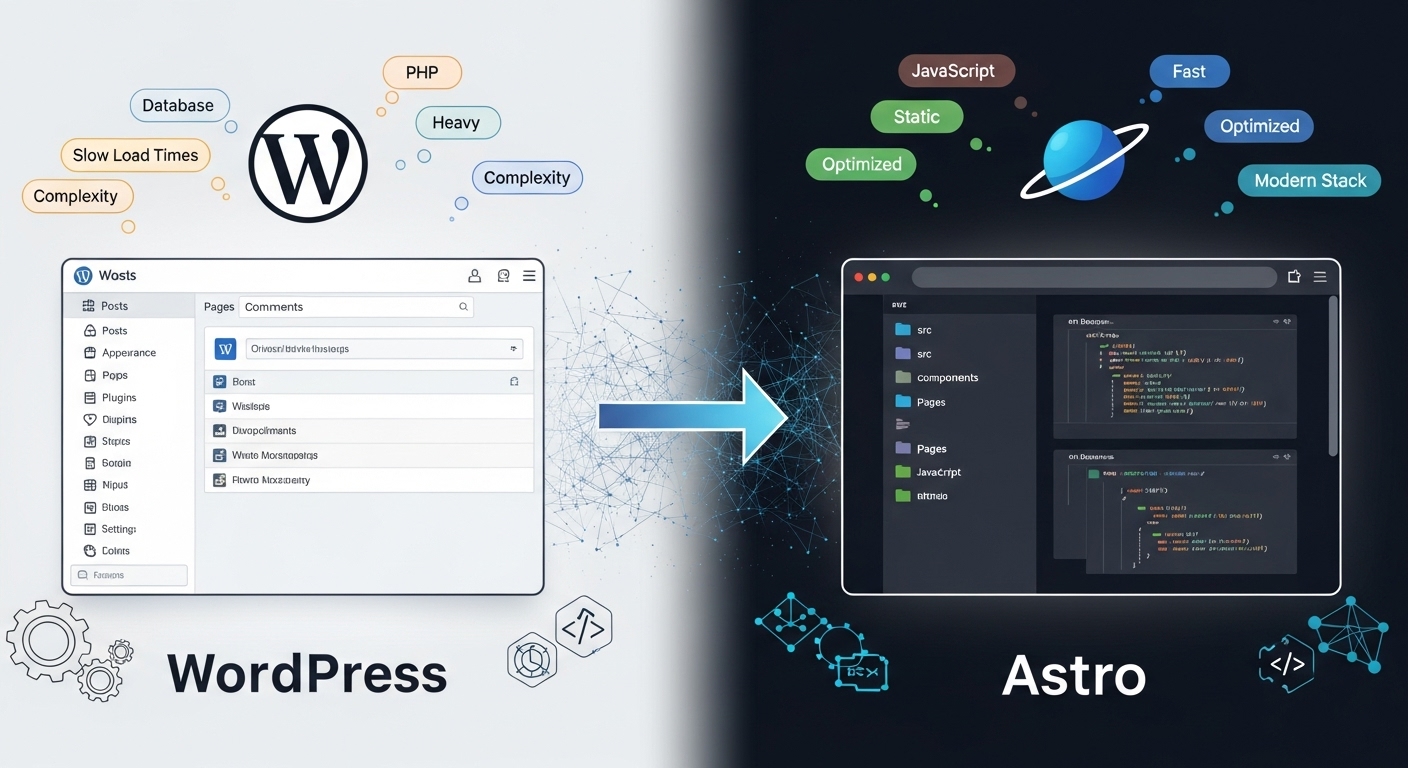As a digital marketing agency, we’re constantly looking for ways to give our clients a competitive edge. Our client had a familiar problem: a website built on WordPress that was struggling to keep up with modern performance standards. What was once a functional site had become a bottleneck for their marketing efforts, so we proposed a new, innovative solution.
The Challenge: Overcoming “WordPress Bloat”
The Client relied heavily on their website to showcase their services and publish their blog. They appreciated the user-friendly WordPress admin dashboard, but the site’s performance had become a major liability.
A Site Plagued by Performance Issues
The site was a classic example of “WordPress bloat.” With each new feature added, a new plugin was installed, resulting in a heavier total JavaScript payload and slower page speeds. The Client’s Google PageSpeed scores were consistently low, particularly on mobile, which directly impacted their User Experience (UX). Key performance metrics like Largest Contentful Paint (LCP) were well outside of acceptable ranges. This was not only frustrating for visitors but was also a negative signal for SEO.
The Maintenance and Security Burden
The Client’s team also spent valuable time managing frequent plugin and theme updates, often worried that a single update could break their site’s functionality. The dynamic, database-driven nature of their existing setup, while functional for content management, came at the cost of security and maintenance overhead.
The Solution: A Strategic Hybrid Approach
To solve these challenges without forcing the Client to abandon their familiar workflow, we proposed a strategic hybrid model. We would build a new, high-performance frontend with Astro while retaining their existing WordPress installation to serve as a headless CMS.
A Modern Stack for a Modern Website
Our solution involved a precise separation of concerns. We redesigned the entire site to be an exact visual replica of their old WordPress theme but built it from the ground up using Astro. The core static pages—Homepage, About, Services, etc.—were hard-coded into the new Astro site for maximum performance.
For dynamic content like their blog posts and portfolio projects, we kept their WordPress installation on a subdomain. We installed the WPGraphQL plugin, which exposed all their content data through a clean, efficient API. A key advantage of using WPGraphQL over a traditional REST API is its ability to fetch only the exact data required for a specific page, avoiding “over-fetching” and further boosting performance. Our new Astro frontend then used this API to fetch the blog and portfolio data at build time, generating a static page for each post. This allowed the Client’s team to continue managing their content in the familiar WordPress dashboard, while the end user experienced the speed and security of a modern, static site.
The Results: Unprecedented Performance Gains
The results of the redesign were dramatic and quantifiable. The Client’s website transformed from a slow, bloated site into a lightning-fast digital asset. We presented the following before-and-after performance metrics to the Client as a key part of our project report.
A Head-to-Head Performance Report
We ran performance audits on both the old WordPress site and the new hybrid Astro version. The results below showcase the dramatic improvements across all pages, including the dynamic content fetching data from WPGraphQL.
| Metric | Client’s Old WordPress Site | Client’s New Astro Site |
|---|---|---|
| Google PageSpeed Score (Mobile) | ~45-60 | 95-100 |
| Largest Contentful Paint (LCP) | ~2.5s | < 0.5s |
| Total JavaScript Payload | ~100-200 KB | < 10 KB |
| Time to First Byte (TTFB) | ~250ms | < 70ms |
| Cumulative Layout Shift (CLS) | > 0.1 | 0.0 |
As you can see, the improvements were dramatic. The Largest Contentful Paint (LCP), a key Core Web Vitals metric, saw a massive reduction, resulting in a superior User Experience (UX).
The Value Beyond the Numbers
Beyond the raw speed scores, the client gained significant long-term value. Their site now has a much lower maintenance and security overhead, and the clean, efficient code base translates directly to a powerful SEO advantage. Furthermore, the cost of ownership was drastically reduced due to the ability to host a static site on a low-cost or even free CDN, a significant improvement over the expensive, managed WordPress hosting they previously required. The separation of the content and development workflows also streamlined our internal processes and empowered the client’s content team.
Conclusion: A Strategic Leap Forward
This case study demonstrates the power of a hybrid approach. By combining the strengths of Astro’s performance with the familiar CMS capabilities of WordPress, we were able to deliver a future-proof website that exceeded our client’s expectations



